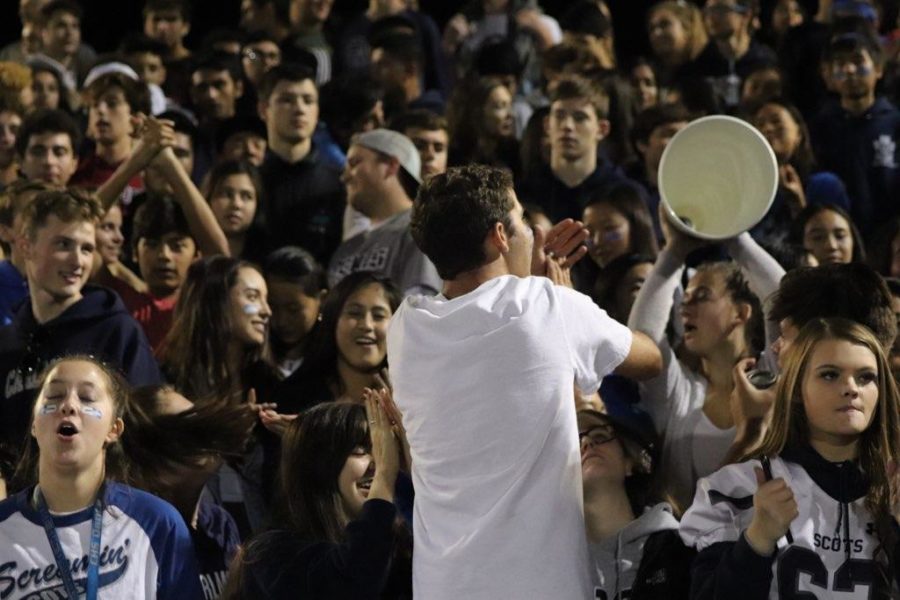The school colors are everywhere, appearing in azure blues and alabaster whites that cover hallways and student apparel alike.
Posters created by ASB flutter on nearby walls as people walk by, dressed in wacky clothes that follow a central theme.
But it isn’t Halloween.
It’s a spirit day.
School spirit fluctuates from school to school. It comes in the form of decorations, events, spirit days, sports, and games, and is generally designed to engage a student in their school community.
Many agree that school spirit can change one’s experience in high school for the better.
“Hopefully school spirit makes coming to school more fun and something you look forward to. It can offer a greater feeling of involvement or belonging,” said history teacher Greg Schoenstein.
Administrative Vice Principal Gregg Patner also believes that participating in spirit has a positive effect on students simply because of human nature.
“When people feel like they belong to something and they’re proud of what they belong to and what they represent, I think they’re going to be their best self,” Patner said.
While the individual student gains happiness from contributing to school spirit, their participation can also helps the school.
“Spirit is a good opportunity to support your school,” said sophomore Carly Ramirez.
Although many believe in the beneficial effects of school spirit, it can be hard to determine whether spirit actually has an effect on students due to the fact that spirit differs between schools.
A study published by the Canadian Center of Science and Education found that academic culture relies on spirit to encourage a person to participate academically in school.
This means that school spirit can possibly be used as a motivator for students. Other studies have revealed a similar link between academic performance and engagement in school spirit.
A survey conducted by Harris Poll found that students who participated in school spirit events “perform better academically, are more socially and civically engaged, and are happier in general than their less-spirited peers.”
ASB and Yearbook supervisor Jim Kelly supports the idea that students will benefit academically from participating in school spirit.
“If students are engaged in their school experience and activities, they’re more likely to be successful students because they want to be here at school,” Kelly said.
Students are not the only people invited to join in during school spirit events. Many teachers also participate in order to inspire other students to partake in the events.
Some teachers, such as Schoenstein, are well-known for their special outfits during spirit days and even build reputations on their ability to display school spirit.
“I try to be a positive role model for students who may be hesitant to participate,” Schoenstein said.
Other adults at Carlmont prefer to leave the dressing up to students. Patner goes to most sports games but doesn’t partake in spirit days.
“I support [the spirit days],” Patner said. “But I think it’s more about the kids. I’m also a shy guy so that’s why I don’t dress up.”
Kelly divides spirit events into two categories in order to try to include as many students and teachers as possible. He aspires to reach out to both more spirit-forward people and more shy people such as Patner.
“We have a spectrum of events that we put on, from low-risk, low trust to high-risk, high trust. The very typical high-risk event would be a dress-up day because there’s a risk to the participant in doing it.”
Sometimes, high-risk events mean that if a student participates, they run the risk of hurting their social image and their friends not participating. However, this isn’t always true, and many people still partake in high-risk events as a way to show pride in their school.
Even if a student or teacher decides not to participate in a typical high-risk event, similar to how Patner chooses not to engage in spirit days, there are also low-risk events and events that combine both high-risk and low-risk activities.
“High-risk usually has about 20 percent participation, while low-risk can have upwards of 60 to 70 percent,” Kelly said. “The best example of [a combination of both high-risk and low-risk] is Meme Day last year which had different layers of risks. The highest risk came from dressing up as a meme, while the lower risk came from simply participating in some of the social media activities that were involved.”
At Carlmont, there is a wide range of events for anyone to participate in. However, many can find it difficult to join in, especially during spirit days.
Some cite peer pressure as a reason for not being able to participate.
“[During freshman year], my friends were less supportive [of spirit days]. They didn’t dress up so I didn’t very often,” Ramirez said.
Another challenge many people face during spirit days is finding the right outfit.
“It can definitely be challenging sometimes to come up with ideas for how to interpret a theme for some spirit days,” Schoenstein said.
Although many people at Carlmont focus on spirit days as their main way of showing school spirit, there are plenty of other ways to show off one’s spirit.
An article on Psychology Today found that “identifying with the sports teams at one’s school may also be good for boosting students’ social connections and reducing isolation.”
Even if a student doesn’t engage in a spirit day, they can still display their spirit through actions such as cheering at a sports game.
“You don’t have to be on the basketball team, the football team, or the volleyball team to be involved in the school. You can be involved in the school by showing up to a game and joining the Screamin’ Scots,” Patner said. “The band is part of the spirit and the cheer is part of the spirit. Plus, they all work together; it’s a very inclusive type of situation.”
Although studies seem to encourage participation in school spirit as a way to boost one’s grades, often times it’s not the deciding factor. There are many students who reach high levels of success in their academic pursuits without attending a single football game or dance.
Thirty percent of students in the survey by Harris Poll recorded not participating in school spirit; however, they continued to maintain above-average grades.
Other students decide that school spirit isn’t for them and choose not to partake in Carlmont spirit-related events.
Sophomore Blake Masters doesn’t participate in such events despite attending a few football games in the past. He believes that spirit is a “relative waste of [his] time” and doesn’t believe spirit is tied to academic success.
Others share Masters’s belief that spirit doesn’t lead to engagement and success in school.
Freshman David Su doesn’t believe that there are any academic positives derived from engaging in school spirit; however, he enjoys seeing other people dress up for spirit days.
At Carlmont, school spirit isn’t limited to a single group of students; it’s open for anyone to take part in. However, ultimately it is up to the student whether or not they would like to participate.
“Everyone can be spirited,” Patner said.













Mr. Kelly • Mar 18, 2019 at 5:21 pm
Jai,
This was an excellent article that I will be using to help teach my classes in the future. Your research and supporting facts and quotes are spot on. Well done! I would like to see something that actually attempts to define school spirit. Too often, most students see it only as the traditional activities like dress up days etc. You did a good job portraying the different types related to the risk taken by the participant. I wonder if the two boys at the end of the article define school spirit any differently than the typical. Either way, such a fine article on a difficult subject for many to comprehend. One of the best I’ve seen from Carlmont Journalism.